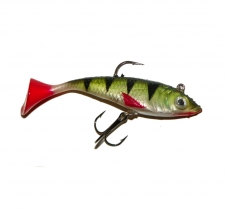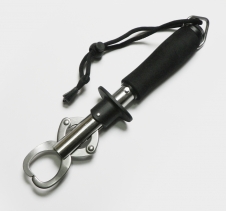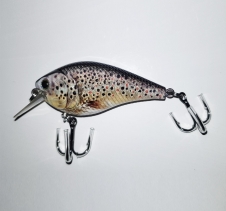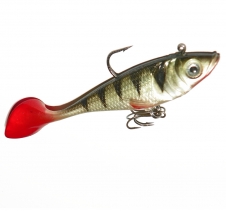Visit Our Online Store! $7 AusPost Parcel Post Delivery FREE Postage for orders $45 and over!
* Shipping rates above apply to Australian Customers only
Fishing for Australian Bass and Estuary Perch.
Australian Bass traits, baits and lures, along with commonly used techniques
.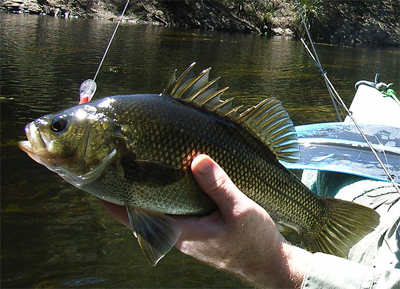 Australian Bass is by far one of the best, if not the best, native sporting fish we have in Australia. They are not an easy target for the angler, and they put up a strong fight once hooked. Catching Australian Bass is much more involving than other native Australian species, albeit on par with the Estuary Perch, which is a very close relation to the Australian Bass.
Australian Bass is by far one of the best, if not the best, native sporting fish we have in Australia. They are not an easy target for the angler, and they put up a strong fight once hooked. Catching Australian Bass is much more involving than other native Australian species, albeit on par with the Estuary Perch, which is a very close relation to the Australian Bass.The debate began around 1960 regarding Estuary Perch and Australian Bass being a separate species, this has since been proven correct with modern DNA analysis. Although their characteristics are very similar, and they are both able to breed together, it is believed that breeding between these two species produces young which are sterile, making them unable to further reproduce. Estuary Perch is named due to the fact they prefer to spend most, if not all, their time in estuary conditions, while the Australian Bass spawns in estuaries then pushes far into upstream freshwater following the event.
Australian Bass can be found in South Australia, Victoria, Queensland, New South Wales and Tasmania. They have also been introduced to some areas in Western Australia. In Victoria, they can normally be found east of Wilsons Promontory. Some have also been introduced to the Yarra River (which is outside of their native Victorian range), where they still survive today in small numbers.
Fishing for them is usually performed on light weight spin rods, using either natural live baits such as crickets and minnows, or spin and hard body lures. Australian Bass will almost never attack a dead bait, so for bait fishermen, live bait will be required. For the lure fisherman, working a spin or hard body lure to provide strong vibrations, either on top of or below the water, is essential.
During dry summer months, the Australian Bass will often hide underneath submerged logs, tree roots, branches or low hanging trees, where they will only attack a bait which gets within their striking range. At night is a different story, as many fish are often at rest, including those the size for a bass to eat, they will leave their hiding spot in order to hunt down prey under the cover of darkness.
Once an Australian Bass has taken a bait or lure, they will often rush quickly towards a suitable hiding spot, which is almost always a prime spot to snag off your fishing line. Immediately after a bass is hooked, you will need to tighten the line and begin to force the fish away from any nearby snags. If the line is allowed any slack, they will sprint towards submerged objects, including plants, weeds, branches and other areas where you will likely be unable to retrieve them. This is because they feel a sense of safety in these areas, and you will need to fight the fish hard to keep them in more open waters if you are going to bring one to land.
Any live bait will often attract a bass, including up to 3 live scrub worms on a hook, fishing worms on a float and jigging the line so the float moves, which will also cause the bait to sway in the water, greatly increases the chances of catching a bass.
Another great bait is live yabbies, when hooking them for bass, you should place the hook through in a way so the yabbies tail is not prevented from extending fully while in the water. Yabbies use their tail to quickly dash around and gain distance in the water in an attempt to escape, Australian Bass love this as it makes them a prime target and very easy to spot.
Flathead Gudgeons are also a common live bait, these minnows can be found in most streams throughout Victoria and up to 20 are currently allowed to be kept on hand for use as bait. You should collect these small fish from the stream you are fishing in to prevent contaminating the river with potential disease which comes from keeping fish in a tank at home. Holding fish in an aquarium tank or pond at home then placing them into public waters is illegal in Victoria, bait fish need to be collected from the same river system as you are fishing.
Keep in mind that a lot of other small fish are either protected species or are introduced pests, on the pest side, there is none more-so than Gambusia, which are commonly and poorly referred to as mosquitofish based on an old assumption they would control mosquitoes if introduced to Australia, researched proved this to be completely untrue, as the small native fish were shown to do a much better job at this). If Gambusia are caught they are not allowed to be returned to the water alive, this applies under the same rules and laws also used for carp and goldfish.
Hooking a flathead gudgeon through the lower jaw and exiting through the top in front of the eyes is often a good way to live bait, as their body is very slim, hooking in other ways can result in them perishing fairly quickly. A treble hook can also be used for this, where by one hook is placed through the jaw, with the two lower hooks resting freely underneath.
The alternative to live bait is always lures, and bass can be hooked on a large variety of them. Poppers can often be productive, along with providing more entertainment as you get to see the fish rise up and take the lure, diving lures also work well, as do soft plastics and spin lures. All lures will need to be worked, either by jigging or other means to make them more attractive to a bass. Fast retrieves on poppers seems to be preferred, especially when adding a short pause.
Whichever type of lure you use, experimenting with your retrieves is going to be required, in order to find the most effective methods for you and your equipment.
Always have an array of lures on hand, as bass are very fussy as to what they will target, some days they will go strong on soft plastics or spinners, while others they will prefer the diving hard body, they may also even reject these two lures and go solely for surface level poppers, leaving those who fish a single type of lure or bait waiting all day for a fish, as you are able to make numerous catches.
Note that with any bait or lure, you will almost always need to entice the bass out of their hiding spot in order to attack. They will rarely come looking for it, nor will they venture too far if they aren't confident of an easy meal.
In fairly shallow waters popper lures can work extremely well. The popper can also be useful in areas with lots of underwater snags, as you can visually see the lure and will be able to work it much easier.
The best method I have found for poppers is the quick dash then pause, you retrieve the lure a short distance quickly, causing a strong water disturbance to occur, then allow the lure to sit in one spot until the ripples in the water completely clear, before proceeding to retrieve again in the same fashion and for the same distance. This gives the fish time to think and assess the chances of being able to take the lure, with the pause this appears to help them make their mind up a lot easier.
Deeper pools of water or faster streams will often mean the bass will be sitting along the bottom, so trying out weighted soft plastics jigged in a jump and pause motion can be productive. Also spin lures retrieved between the middle and bottom of the water, adding some variation in each retrieve.
Diving hard bodies at various depths depending on the conditions are also a common choice.
As mentioned before though, be prepared to change lure styles if one does not prove successful after a short period of time, you may be surprised how well you do on a specific type of lure compared to sticking it out with one that isn't producing any fish.
When nothing seems to be working, don't be afraid to try a larger lure, one around 10cm is a perfect upgrade, while smaller bass will normally be scared off or ignore a lure this size, big bass can take the opportunity for a proper sized feed, which could make all the difference to your outing.
Most of the time you will not catch large amounts of bass in a single outing, the maximum is usually around 2 or 3 on a good day, but the techniques you use will also be suited to other predatory fish in the area, so you can get some by-catches to sustain you until a bass is found. The techniques used for bass fishing will often be suited to a number of other predatory fish including redfin perch, trout and native perches should they be present.
If fishing for Estuary Perch, the same techniques as bass are used, baby mullet can be caught and used as live bait in estuary conditions, salt water yabbies can also be obtained usually by using a bait pump in water soaked sand areas (where tidal influence is present), or regular store bought prawns for dead bait (I personally prefer fresh prawns from the local seafood store or supermarket, not frozen prawns). The fight of Estuary Perch is very much the same as Australian Bass, except for the obvious fact you will be fishing in estuarine conditions.
Common by-catches in these waters will mostly be bream, but potential is also there for a few other species such as baby snapper, bottom jigging can be productive for flathead which stick to the bottom of the waters and are also an ambush predator, further more Australian Bass during their spawning season (June to early September) can also be included as a potential estuary catch, along with many other species which varies in each region.
Follow us on twitter: @FishTackleLures or Google Plus: +FishingTackleLuresAU
View more articles in our Australian Fishing Guide.
Enter your email address below to be updated on new fishing articles, fishing lures and special offers:
We will only email once every two to four weeks at the most, usually every 2 months.
POPULAR PRODUCTS IN OUR ONLINE STORE


